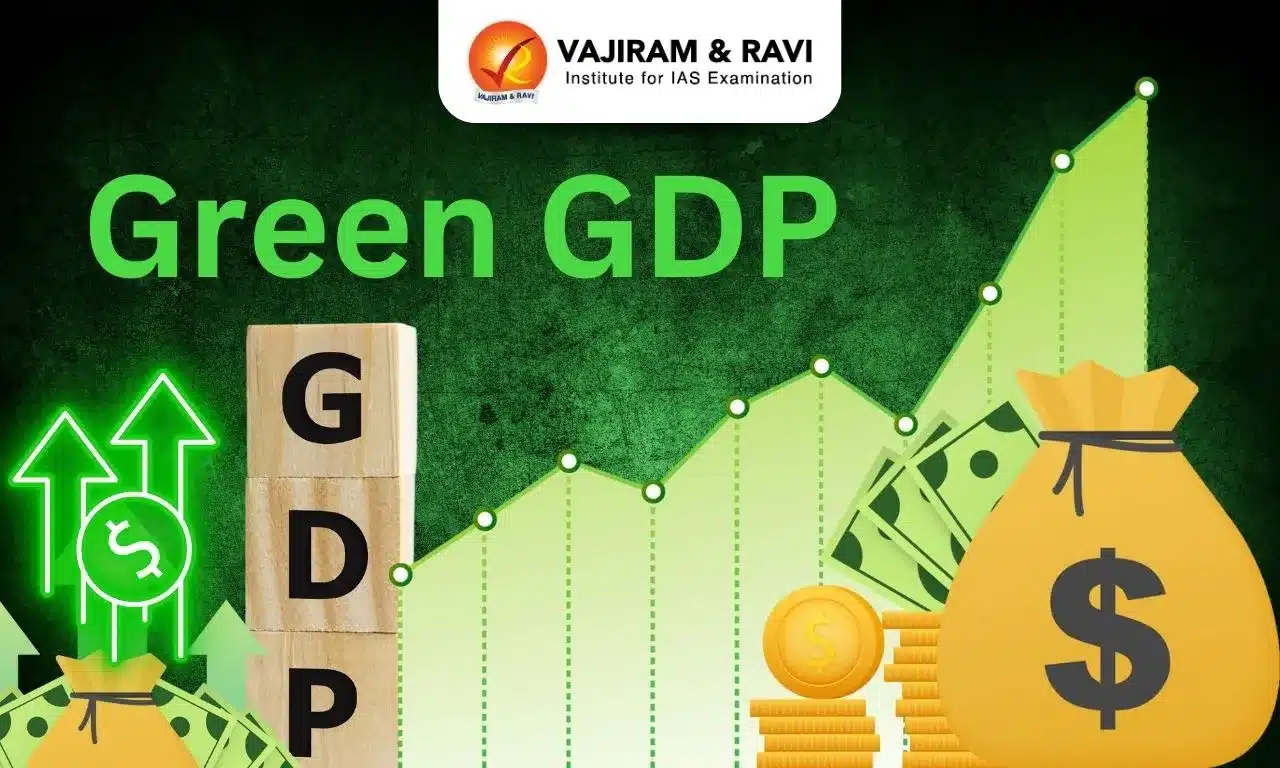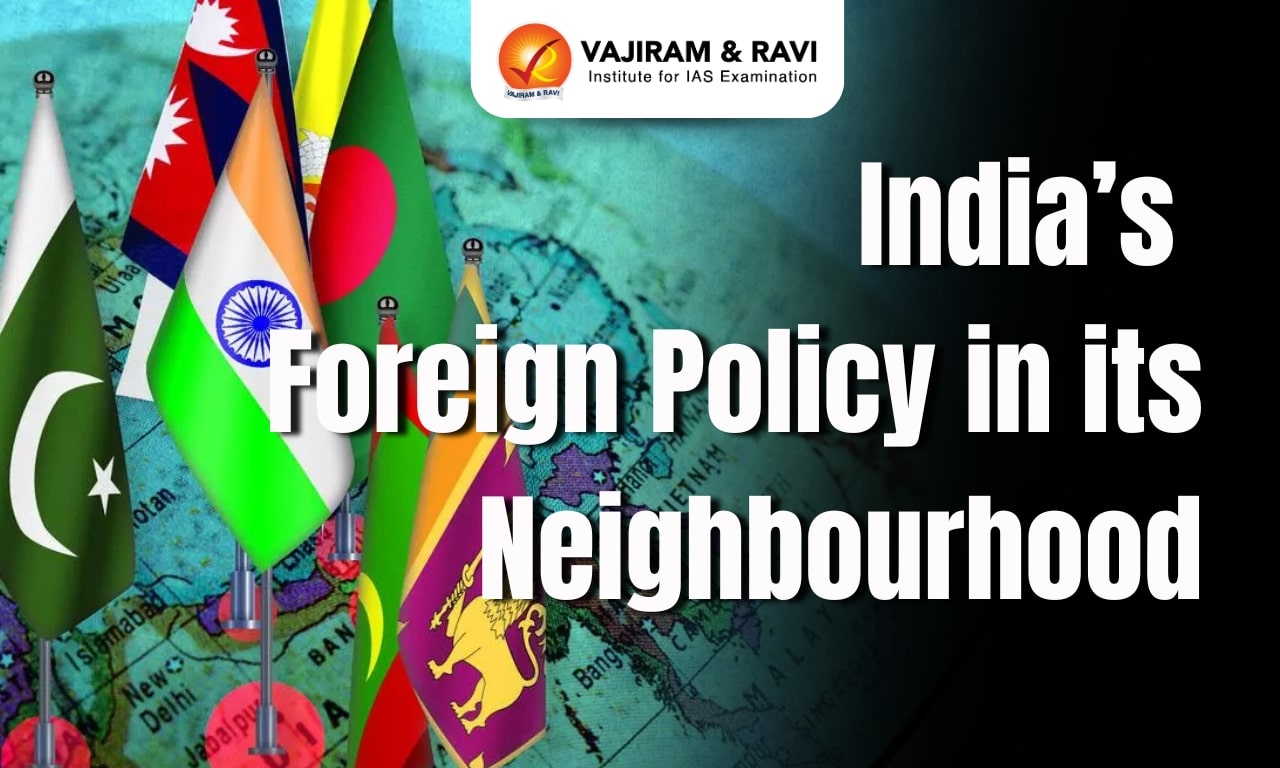Green GDP is an alternative economic indicator that integrates the environmental costs of economic growth, accounting for natural resource depletion and ecological degradation. Unlike conventional Gross Domestic Product (GDP), which focuses solely on economic output, Green GDP accounts for natural resource depletion, environmental degradation, and societal well-being.
Redefining production, consumption, and investment through an environmentally conscious lens encourages sustainable development and long-term resilience. With nations like China, Bhutan, and the European Union adopting Green GDP principles, this framework emphasises balancing economic growth with ecological preservation to secure a sustainable future for all.
What is Green GDP?
The Green Gross Domestic Product (Green-GDP) is an alternative economic indicator that integrates the environmental costs of economic growth, accounting for natural resource depletion and ecological degradation. It provides a more accurate measure of a nation's economic and environmental well-being.
- Objectives: Green GDP aims to incorporate environmental considerations into traditional economic metrics by redefining production, consumption, and wealth. It highlights the stock of environmental resources and their depletion, encouraging sustainable economic practices.
- The Environmental Kuznets Curve (EKC): It shows an inverted "U" link between economic growth and environmental harm: growth initially worsens degradation but improves it after reaching a turning point, driven by technology and cleaner practices.
Features of Green GDP
Green GDP is a progressive approach to measuring economic performance by integrating environmental considerations. By accounting for the environmental impacts of production, consumption, investment, and human capital, it offers a balanced framework for assessing economic activities. The key features are outlined below:
- Incorporation of Environmental Impact: Green GDP accounts for both environmentally beneficial and harmful products, ensuring a balanced reflection of their social value within economic activities.
- Segregation of Economic Activities:
- Production: Includes categorization of goods and services as environmentally beneficial or harmful.
- Consumption: Final consumption is segregated into categories such as zero-carbon, less environmentally degrading, and majorly environment-depleting products.
- Investment: Differentiates between investments in zero-carbon technologies and conventional carbon-intensive technologies.
- Human Capital: Splits jobs into conservation-related and conventional sectors, reflecting their respective contributions to green and conventional technologies.
- Government Revenue and Subsidies
- Taxation: Highlights taxes imposed on polluting industries and subsidies provided to environment-friendly technologies.
- Subsidies: Focuses on financial incentives for environment-conserving and efficient technologies.
Need for Green GDP
Traditional GDP focuses solely on economic output, overlooking sustainability, environmental degradation, and social welfare. In contrast, Green GDP incorporates these critical factors, emphasizing sustainable development by balancing economic activity with ecological and social well-being. The key features of Traditional GDP and Green GDP are explained below in the table:
| Aspect | Gross Domestic Product (GDP) | Green GDP |
| Focus | Measures total economic output without considering sustainability or externalities. | Adjusts economic output to include environmental and social costs, reflecting sustainable progress. |
| Environmental Consideration | Excludes the costs of pollution, resource depletion, and environmental degradation. | Accounts for environmental degradation, resource depletion, and pollution costs. |
| Social Welfare Reflection | Does not measure income inequality, quality of life, or overall social well-being. | Includes social factors, aiming to reflect broader social welfare and equity. |
| Sustainability | Neglects long-term sustainability, focusing only on short-term economic gains. | Emphasizes sustainable development, integrating long-term ecological and economic considerations. |
| Indicator of Development | Captures only economic productivity, often overlooking the costs of achieving it. | Reflects real wealth by balancing economic activity with ecological and social well-being. |
Key Principles of Green GDP
Green GDP integrates economic and ecological considerations by assigning monetary values to ecosystem services, resource depletion, and environmental damage. Through approaches like adjustments to traditional GDP and environmental indicators, it provides a comprehensive framework for evaluating sustainability. The key principles of green GDP are explained below :
- Environmental Valuation: Assign monetary values to ecosystem services (e.g., carbon sequestration, water filtration) and natural resources (e.g., forests, water bodies) using methods like market price or replacement cost.
- Natural Resource Depletion: Evaluate the environmental cost of non-renewable and renewable resource extraction, considering rates of consumption and depletion.
- Pollution and Environmental Damage: Estimate costs of pollution (air, water, soil) and environmental harm, including biodiversity loss and greenhouse gas emissions.
- Adjustments to Traditional GDP: Incorporate environmental costs by deducting resource depletion and damage or adding the value of environmental services.
- Environmental Indicators: Utilize metrics like carbon and water footprints, energy use, and pollutant emissions to assess environmental performance comprehensively.
- Integrated Approaches: Adopt models like the System of Environmental-Economic Accounting (SEEA) to merge economic and environmental data for a holistic evaluation of sustainability.
Green GDP Formula
The formula for calculating Green GDP combines environmental and economic variables, offering a comprehensive framework for assessing sustainable development. This method provides a balanced perspective on economic growth by accounting for its ecological and societal impacts.
Green GDP = GDP – (P1 – MC1) Dnr – (P2 – MC2) Dr – V Ds; where:
- P1: price of non-renewable resources;
- P2: price of renewable resources;
- MC1: Marginal cost of non-renewable resources;
- MC2: marginal cost of renewable resources;
- Dnr: change in the stock of non-renewable resources;
- Dr: change in the stock of renewable resources;
- V: marginal cost of abatement of pollution;
- Ds: change in the pollution stock S.
Significance of Green GDP
Green GDP emphasizes integrating environmental preservation and sustainable practices into economic growth. By addressing climate change, promoting resource efficiency, and safeguarding ecosystems, it ensures long-term environmental balance and sustainable development while fostering innovation and resilience. The significance of Green GDP is explained below:
- Preservation of Ecosystem Services: Maintaining vital services like clean air, water, and fertile soil ensures sustainable economic activities and protects resources for future generations, fostering long-term environmental balance.
- Addressing Climate Change: Reducing reliance on fossil fuels and adopting renewable energy sources mitigate greenhouse gas emissions and combat climate change, ensuring a healthier planet.
- Conserving Biodiversity: Balancing development with ecological preservation safeguards species, protects natural habitats, and maintains the critical ecosystem balance necessary for survival.
- Promoting Resource Efficiency: Encouraging sustainable production and consumption reduces waste, conserves resources, and minimizes environmental pollution, promoting sustainable growth.
- Building Resilience: Adopting adaptive strategies strengthens economies and communities against environmental risks like extreme weather and resource scarcity, improving their capacity to cope.
- Promoting Sustainable Development: Ensuring growth aligns with environmental conservation and addresses current needs without compromising future resources, securing intergenerational equity.
- Safeguarding Human Health: Reducing pollution and improving air and water quality through sustainable practices enhances public health and well-being, reducing disease burden.
- Addressing Environmental Concerns: Integrating sustainability into growth strategies ensures economic stability and fosters a fair and resilient future for all generations, protecting natural wealth.
- Green Innovation and Technology: Green GDP can encourage creativity and the creation of eco-friendly technologies. It generates market incentives for the adoption and advancement of clean technologies, renewable energy sources, and sustainable practices by highlighting the environmental effects of economic activities.
Challenges in Implementing Green GDP
Green GDP seeks to incorporate environmental and sustainability considerations into economic metrics, offering a more holistic view of growth. However, challenges such as complex valuation, data limitations, and global disparities hinder its implementation and standardization across regions. The challenges of Green GDP are as follows:
- Complex Valuation: Quantifying the cost of natural resource depletion and ecological damage is difficult and often subjective.
- Data Limitations: Reliable data on environmental costs are not consistently available.
- Methodological Ambiguity: Discrepancies in valuation methods and weightings can lead to varied outcomes.
- Comparison Issues: Standardizing Green GDP metrics for international comparisons remains problematic.
- Global Disparities: Developed nations consume disproportionately higher resources, and their ecological impacts often affect distant regions, highlighting the need for sustainable development metrics.
- Long-Term Need: Over time, tracking economic progress will necessitate combining traditional GDP with metrics for natural, social, and human capital changes.
Green GDP in Practice
Green GDP integrates environmental sustainability with economic growth, representing a shift toward holistic development that considers ecological well-being. Different nations and regions have adopted diverse approaches to implementing Green GDP. Below are examples of how various countries and regions are implementing Green GDP principles:
- India: Striving to contribute to Green GDP, it incorporates environmental costs into economic metrics. Through Mission Innovation, India leads efforts with 23 nations and the EU to accelerate clean energy solutions and align growth with sustainability.
- European Union (EU): Through the Beyond GDP initiative and frameworks like SEEA, the EU prioritizes sustainability metrics to supplement traditional GDP.
- China: Explored Green GDP since the 2000s, focusing on green accounting and environmental-economic indicators despite challenges like data shortages and reliance on traditional GDP metrics.
- New Zealand: Pioneered the Living Standards Framework, integrating social, environmental, and economic well-being into national decision-making.
- Bhutan: Adopted the Gross National Happiness (GNH) framework, emphasizing ecological sustainability as a core pillar for holistic development.
- The Green Economy Initiative (GEI) is a United Nations Environment Programme (UNEP) initiative that encourages policymakers to support environmental investments.
Green GDP Way Forward
The Green GDP is a transformative tool that harmonizes economic growth with ecological preservation. Integrating environmental factors into economic measures fosters sustainable practices, supports informed policymaking, and advances global sustainability goals while addressing challenges in valuation and resilience. The future aspects of Green GDP are explained below:
- Paradigm Shift in Economic Assessment: Integrating environmental factors into economic measures transforms how nations evaluate success, aligning growth with sustainability.
- Transition to a Low-Carbon Economy: Encourages resource efficiency, green innovations, and the growth of sustainable businesses, reducing environmental risks.
- Informed Decision-Making: Provides critical data for policymakers to balance ecological integrity with economic growth through targeted interventions.
- Global Comparability: Enables cross-nation performance comparisons, advancing global sustainability goals.
- Challenges in Measurement: Assigning monetary value to ecosystem services and biodiversity remains complex, requiring robust and reliable methodologies.
- Opportunities in Green Markets: Rising consumer demand for eco-friendly products fosters new markets, driving innovation and green job creation.
- Resilience and Risk Management: Promotes long-term resource availability, mitigates environmental threats, and enhances societal resilience to ecological challenges.
- Health and Social Benefits: Enhances public health, equity, and overall social well-being through sustainable economic practices.
Last updated on December, 2025
→ Check out the latest UPSC Syllabus 2026 here.
→ Join Vajiram & Ravi’s Interview Guidance Programme for expert help to crack your final UPSC stage.
→ UPSC Mains Result 2025 is now out.
→ UPSC Notification 2026 is scheduled to be released on January 14, 2026.
→ UPSC Calendar 2026 is released on 15th May, 2025.
→ The UPSC Vacancy 2025 were released 1129, out of which 979 were for UPSC CSE and remaining 150 are for UPSC IFoS.
→ UPSC Prelims 2026 will be conducted on 24th May, 2026 & UPSC Mains 2026 will be conducted on 21st August 2026.
→ The UPSC Selection Process is of 3 stages-Prelims, Mains and Interview.
→ UPSC Result 2024 is released with latest UPSC Marksheet 2024. Check Now!
→ UPSC Prelims Result 2025 is out now for the CSE held on 25 May 2025.
→ UPSC Toppers List 2024 is released now. Shakti Dubey is UPSC AIR 1 2024 Topper.
→ UPSC Prelims Question Paper 2025 and Unofficial Prelims Answer Key 2025 are available now.
→ UPSC Mains Question Paper 2025 is out for Essay, GS 1, 2, 3 & GS 4.
→ UPSC Mains Indian Language Question Paper 2025 is now out.
→ UPSC Mains Optional Question Paper 2025 is now out.
→ Also check Best IAS Coaching in Delhi
Green GDP FAQs
Q1. What is Green GDP?+
Q2. Why is Green GDP important?+
Q3. How is Green GDP calculated?+
Q4. What are the challenges in implementing Green GDP?+
Q5. Which countries have adopted Green GDP practices?.+

















